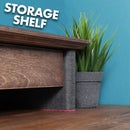Introduction: Build or Buy? Radiator Cover
As a 'maker' I always think it is better to build something rather than buy it. But is that always the case? This is what I want to investigate with my Build or Buy series of videos.
My cousin was going to buy a radiator cover so I offered to make one for him instead.
If you would sooner watch how I made it, you can watch my video here:
Tools used:
- Table Saw
- Mitre Saw
- Biscuit Joiner
- Orbital Sander
- Drill
- Dowel Centre Points
- X-Carve CNC - Not needed!
- Clamps
Materials Used:
- 18mm MDF
- 6mm MDF
- #20 Biscuits
- 6mm Wooden Dowels
- MDF Sealer
- Paint
- Wood Glue
- Sand Paper
Step 1: Is It Worth Building & Creating Cutting List
I wanted to make sure that it was infact cheaper to build the radiator cover compared to buying one.
I created a list of prices to compare the 2 options. I found it was cheaper to build in my case. You have a lot more control over design and dimensions too.
I went ahead and designed the project on google sketchup and then created a cutting list from that design.
Step 2: Cutting the Parts
I started by cutting the MDF into the series of widths I would need. I did this on my table saw.
It is a simple repetative process but remember to wear the relevant safety gear. Eye protection and a respirator is a must when working with MDF.
Once I had the widths I needed I moved over to the mitre saw to cut them to the correct lengths. I ticked of each piece on my cutting list so I could keep track of my progress easily.
Step 3: Layout, Mark Up, Cut Biscuits, Glue Up
Once all my pieces were cut I layed them out how they would be assembles. I was using a biscuit joiner to join the pieces together so I used a pencil to put marks where I would cut slots for the biscuits.
I could then use the marks to cut the slots ready for glue and biscuits. For the legs of the cover there is a 10mm reveal so I adjusted my biscuit joiner higher by 10mm to give me the reveal I wanted. I then cut the slots in the legs.
I glues up the front panel first. I had to do it in 2 steps because the clamps I have arent long enough to do it in 1. I let that dry overnight.
Step 4: Router Groove for Panels, Glue on Legs
I was going to add 2 panels to the front of the conver. Just a simple striped patter. I wanted to create a groove to bring the panels closer to the front and also give me a place to glue them in.
I use my router to create the grooves all the way around the 2 opening in the front panel.
After that was done, I glued on the side pieces to create the legs to the radiator cover, with the 10mm reveal.
Step 5: Add the Top Shelf
I used dowels to attach the top as I feel they are easier to line up than biscuits.
I drilles 6mm holes in the top of the raditor cover at each of the points where the top would meet the shelf. I then put in the dowel centre points.
I lined up the shelf ontop of the dowel centre points and made sure it had the same reveal all the way around. Apart from the back where it needed to be flush.
I then tapped along the shelf with a hammer to leave a mark where to drill the corresponding holes for the dowels in the shelf.
I then just drilled the 6mm holes in the shelf and glues it to the base using 6mm wooden dowels.
Step 6: Front Panels
For the front panels I was intending to just cut 45mm strips of 6mm MDF. I had a run of bad health during this project so I opted to use my CNC machine to cut out the panels for me. This would make the most of my time. You of course dont need a CNC to get the same results.
I just had to sand and glue the panels into place.
Step 7: Sand, Seal & Deliver
The last step is the best bit.... not. I sanded all of the radiator cover to knock of the sharp ades and make sure everything was smooth to the touch.
I brushed on some MDF sealer to help when painting later. It should help the pant cover the MDF rather than soaking in.
My cousin wanted to paint the radiator cover so this was the last time I had my hands on it. They chose white paint for the radiator cover and I think it turned out great.
I hope you like this instructable and I hope you feel inspired to make your own instead of buying one.

Participated in the
Furniture Hacks Contest

Participated in the
Homemade Gifts Contest 2015













